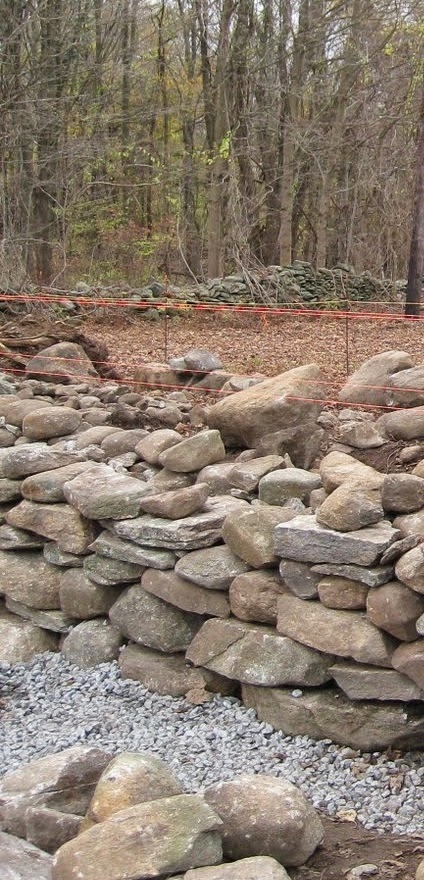It was another “Looking
for Something Else and I Found This” Situation that brought me to someone’s
photos about a 2 day stonewall workshop that involved rebuilding an old “stone
wall.” It happened five years ago and I don’t want to embarrass the people who
participated.
They really didn't understand what that row of stones was,
what it was actually composed of.
They didn't know that it was an Indigenous made stone
construction.
Read just about any book about stone walls and you won’t
find this type of “wall,” actually, properly and technically a “fence,”
described in those books. At best you’ll find it described as a haphazard
collection of stones tossed out of a field and possibly stacked in a double row
in a rather random matter. But I quickly spotted a few details I've seen elsewhere that leads me to believe that there isn't isn’t anything random about it,
excepting that some stones may have been actually added after people began
plowing and clearing the field of stones.
I hypothesize that Indigenous People in what is now known as
New England built miles and miles of what are known as “stone walls.” I’ve been
field observing “stone walls” for over twenty years, that Indigenous-made
perspective in mind, looking for repeated patterns that suggest an Indigenous (Indian
or Native American) origin.
Just as some authorizes say about other rock art in this
region, representations of the turtle and the serpent are probably the most common (Ed
Lenik somewhere or other comes to mind) signatures of Indigenous constructions.
Representations of turtles seem most numerous (and it’s a whole other story
that there are many rows of stones that I interpret as actually being
representations of serpents – petroforms really). I've never kept a count of
exactly how many I've come across and it’s been a learning process as well as I
continue to learn new forms, different patterns…
It took just
seconds to spot a beautiful stone turtle effigy or representation; sometimes I
will enhance a photo to emphasize eyes or a mouth, legs or shell, but I don’t
think I have to in this case:
(Carapace or shell above a headstone looking sideways toward the camera, a dark crystal of the reptile's right eye, a vien of dark minerals in the stone recall a mouth and two forelegs.)
Another obvious testudinate effigy included in this row
of stones, triangular headstone at the nuchal notch of a carapace stone (and is that a rather rhomboidal xenolith just above the notch?):
A (red?) possibly quartzite turtle head stone with well defined eye peeking out from the far side:
A view of the rebuilt wall with an older row of stones in the distance:
(Note the "wave" in the older construction, a wave not unlike the rims of some Indigenous Ceramic Pottery found in the NE that I and others have observed in many "stone walls.")
Another view of the finished stone fence:
(To the left of the finished fence, a stone with the suggestion of eyes, another with a "vee" to suggest a turtle beak, another pattern that occurs often in other stones observed over the years:)







Tim, please, you know better than this poppycock
ReplyDeleteThe National Park Service recognizes the existence of Ceremonial Stone Landscapes, uses such details in features to identify this Indigenous style of stonewrok. Take a look at the National Center for Preservation Technology and Training Video on Ceremonial Stone Landscapes - which includes the Killingworth Turtle:
ReplyDeletehttps://www.ncptt.nps.gov/blog/ceremonial-stone-landscapes/
Another, ibid: https://www.ncptt.nps.gov/blog/ceremonial-stone-landscapes-of-new-england-and-developing-best-practices-to-assess-submerged-paleocultural-landscapes/
ReplyDeleteAnd by "stonewrok" I mean "stonework!"
ReplyDelete"...one must realize that much of the history we were taught in school about the pre-European history of New England was based on a deep and pervasive cultural bias. Until recently, there were academics, “experts” in the field of archaeology and anthropology, who asserted that the New England American Indians did not build with stone. (Some also said there were no Native Americans in Vermont!)
ReplyDeleteAlthough much has been destroyed or misidentified, stone monuments, earthworks, burials and other evidence of the existence of a highly developed culture remain. The monuments, although very similar to ancient monuments worldwide, were deliberately disconnected from the true history of the native culture. Much of this cultural denial was perpetrated by English land speculators, and by some Christian ministers whose goal, as worded by Rev. John Eliot was to, “to convince, bridle, restrain and civilize” the Indians “and also to humble them”.
Because of this deep cultural bias, the lithic remains of the Native Americans of New England remained hidden in plain view for centuries. Many of these features are constructed with stone and blend quietly and reverently into the natural surroundings. Yet, once one awakens to their presence they seem to be everywhere. Most were constructed hundreds, even thousands of years ago, when the Indians burned much of the land to control the vegetation and foliage did not obstruct the sightlines. Often these monuments lead the eyes to the place where the earth meets the sky...Other Native American stone structures include prayer seats, stone rows, burial mounds, memorial piles, observation mounds, standing stones, perched boulders, balanced rocks, rocking stones, notched stones, effigy stones, effigy mounds, stone chambers, and Manitou stones. Manitou stones are found in varying sizes. Shaped in the form of a head and shoulders, they might be found standing alone, built into a stone row, or placed on a stone mound... Over the years, most of these monuments were misidentified due to the prevailing cultural bias..." Diane Dix
writing at http://nolumbekaproject.blogspot.com/p/to-preserve-that-which-is-sacred-by.html
Tim the wall that was rebuilt during the workshop was a colonial wall probably built mid nineteenth century. If there was a wall there before the mid 1800's rebuild/build that's your domain. The wall I rebuilt was colonial, rebuilt in a colonial style. End of story.
ReplyDelete